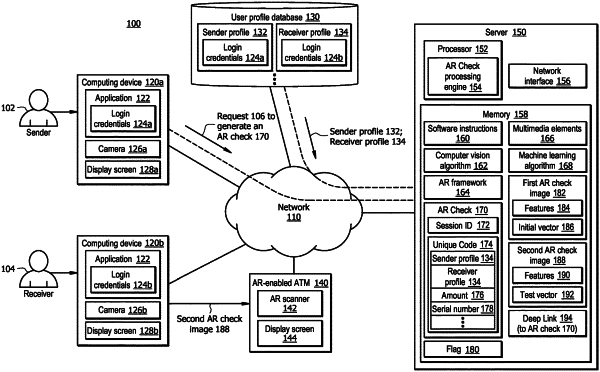| CPC G06Q 20/042 (2013.01) [G06F 21/32 (2013.01); G06F 21/40 (2013.01); G06Q 20/223 (2013.01); G06T 19/006 (2013.01)] | 20 Claims |

|
1. A system for Augmented Reality (AR) document generation and validation, comprising:
a processor configured to:
receive a request to generate an AR document directed to a particular receiver;
associate a session identification (ID) to the AR document to keep track of the status of the AR document;
generate a unique code for the AR document, wherein generating the unique code comprises converting, by implementing a hash function, one or more of a name of a sender of the AR document, a name of the particular receiver, the session ID, and a serial number associated with the AR document into a data format comprising a hexadecimal format;
generate, by implementing a computer vision algorithm, the AR document based at least upon the unique code as an input, wherein:
generating the AR document comprises:
simulate a three-dimensional template image of the AR document;
extract, from the unique code, the one or more of the name of the sender, the name of the particular receiver, and the serial number;
determine multimedia elements that represent the one or more of the name of the sender, the name of the particular receiver, and the serial number extracted from the unique code, wherein the multimedia elements comprise at least one of a set of alphabet letters and a set of number;
determine positions of the name of the sender, the name of the particular receiver, and the serial number on the three-dimensional template image of the AR document using AR markers, comprising determine that a first AR marker indicates a position of the name of the sender on the three-dimensional template image of the AR document, wherein the first AR marker is positioned on a first pixel where a first string associated with the name of the sender is displayed; and
digitally write, using the determined multimedia elements and the determined positions, the one or more of the name of the sender, the name of the particular receiver, and the serial number on the three-dimensional template image of the AR document;
adjust spatial geometries of the name of the sender, the name of the particular receiver, and the serial number relative to a special geometry of the AR document as the AR document moves or is moved in a three-dimensional environment displayed on a display screen of a first computing device;
transmit a first image of the AR document to a second computing device associated with the particular receiver;
receive a second image of the AR document from the second computing device, wherein the second image of the AR document is represented as a digitized three-dimensional image;
determine, by implementing a machine learning algorithm, whether the second image of the AR document is valid, wherein determining whether the second image of the AR document is valid comprises:
extract a first set of features from the first image of the AR document, wherein the first set of features comprises one or more of the name of the sender, the name of the particular receiver, and the serial number, wherein the first set of features is represented by an initial vector comprising a first set of numerical values;
extract a second set of features from the second image of the AR document, wherein the second set of features comprises one or more of a second name associated with the sender, a second name associated with the particular receiver, and a second serial number, wherein the second set of features is represented by a test vector comprising a second set of numerical values;
compare each numerical value of the initial vector with a counterpart numerical value of the test vector;
determine that more than a threshold percentage of the first set of numerical values correspond to counterpart numerical values of the second set of numerical values; and
in response to determining that more than the threshold percentage of the first set of numerical values correspond to counterpart numerical values of the second set of numerical values:
determine that the second image of the AR document is valid; and
transfer information indicated on the AR document to a profile associated with the particular receiver;
a memory, operably coupled with the processor, operable to store the first image of the AR document, wherein the first image of the AR document is represented as a digitized three-dimensional image in a view of a camera.
|